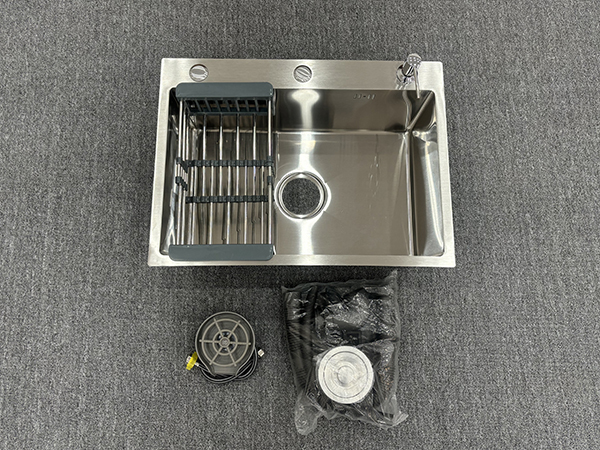
Kitchen Single Sink
Choosing a suitable stainless steel Kitchen Single Sink requires consideration of multiple factors such as size, material, thickness, etc. Here are some key factors:
size
Measure installation space: Before purchasing a sink, it is necessary to accurately measure the available space on the kitchen countertop. Generally speaking, the length of a single sink should be 10-20 centimeters shorter than the length of the countertop and 5-10 centimeters narrower than the width of the countertop to ensure sufficient space for installation and use. At the same time, the depth of the sink should also be considered, with common depths ranging from 18-25 centimeters. Deeper sinks can prevent water from splashing out, but should be selected based on the height of the cabinet to avoid excessive bending during use.
Considering usage requirements: If the household has a large population and a heavy workload such as washing dishes and vegetables, it is recommended to choose a larger sized sink to provide more ample operating space; If the kitchen space is limited or the daily usage frequency is not high, a smaller sized sink can be chosen to save space.
material
Stainless steel type: Stainless steel sinks on the market are mostly made of 304 stainless steel, which has good corrosion resistance, wear resistance, and toughness, is not easy to rust and deform, and meets food hygiene standards, making it an ideal choice.
Surface treatment: Common methods include wire drawing and mirror finish treatment. The surface of the sink treated with wire drawing has fine textures, which can effectively hide fingerprints and water stains, making it visually softer and more wear-resistant; The surface of the mirror treated sink is as bright as a mirror, with high aesthetic appeal, but it is prone to leaving fingerprints and water stains, requiring more frequent cleaning.
thickness
Generally speaking, the thickness of stainless steel sinks is between 0.8-1.2 millimeters. The larger the thickness, the higher the quality and durability of the sink, which can better withstand collisions and friction in daily use, but the price is relatively expensive. For ordinary household use, a 1.0mm thick sink usually meets the needs, balancing cost-effectiveness and practicality.
Basin design
Single groove depth: A deeper single groove can prevent water from splashing out and accommodate larger cookware for easy cleaning. It is generally recommended to choose a sink with a depth of 18 centimeters or more to provide a better user experience.
Sink corners: Corner design is also important, rounded corners are not only beautiful, but also easy to clean and not prone to dirt accumulation; The sink with right angled edges may look simpler, but it can be relatively troublesome to clean.
Overflow outlet: Some sinks have overflow outlet designs, which prevent water from overflowing onto the countertop when the water in the sink exceeds a certain height. This is a practical feature that can avoid the phenomenon of flooding due to negligence.
accessory
Faucet: Faucet is an important accessory for sinks, and it is important to choose products with good quality, smooth water flow, and flexible opening and closing. Common faucets can be divided into single hole, double hole, and three hole types, and the selection should be based on the number of holes in the sink. In addition, the material of the faucet is also crucial, preferably copper or stainless steel, and chrome plating on the surface can effectively prevent rust and corrosion.
Sinker: The sealing performance of the sinker directly affects the effectiveness of the sink, and products with good sealing, smooth drainage, and less likely to clog should be selected. There are various types of sinkers on the market now, such as bounce type, flip type, etc., which can be selected according to personal usage habits.
Brand and after-sales service
Brand: Well known brand sinks are usually more guaranteed in terms of quality, craftsmanship, and after-sales service. You can learn about the reputation and product quality of different brands through the internet, friend recommendations, and other means, and choose brands with high credibility.
After sales: Good after-sales service can make consumers feel more at ease during use. When purchasing a sink, it is important to understand the merchant's after-sales service policy, including product warranty period, return and exchange policy, etc. Some brands also offer free installation, maintenance, and other services, which are factors to consider when choosing a sink.
How to choose a sink suitable for your kitchen?
Choosing a sink that suits your kitchen requires comprehensive consideration of multiple fa ...
2025-05-12
Possible issues that may arise during the use and installation of kitchen sinks
There may be various problems during the use and installation of kitchen sinks, and the fol ...
2025-05-12
How to choose a suitable stainless steel sink
A good stainless steel sink uses thicker plates,and the thickness can be determined by slig ...
2025-04-10
How to choose a kitchen sink
Stainless steel:It has the advantages of strong corrosion resistance,not easy to rust,easy ...
2025-04-10


